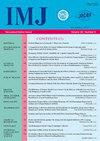MATHEMATICAL MODEL TO PREDICT SEVERITY OF CORONAVIRUS INFECTION AND MAIN ANTI-EPIDEMIC MEASURES IN UKRAINE
Q4 Medicine
引用次数: 0
Abstract
Currently, the epidemic situation regarding the incidence of coronavirus infection COVID−19 in Ukraine continues to be tense. In order to in−depth study of the problem of clinical features, treatment and prevention of this disease, as well as the development of a mathematical model for predicting the severity of its course, 30 patients aged 18 to 85 years were examined. Among the patients there were young and middle−aged people as well as elderly patients with chronic diseases, namely obesity, hypertension, diabetes. The diagnosis of coronavirus infection was confirmed in all the patients by molecular genetic method, i.e. SARS−CoV−2 RNA was isolated, and in 10 patients − IgM + IgG to SARS was determined by immunochromatographic analysis. With COVID−19, young and middle−aged patients have a fairly mild course with a decrease in platelet count by 7 %, erythrocyte sedimentation rate by 48 %, prothrombin by 14 % and D−dimer by 31 %. The construction of regression equations based on trend lines revealed that in elderly patients after treatment there was a further decrease in the level of D−dimer (20 %), an increase in platelet count (30 %), a decrease in white blood cell count (26 %), neutrophils (38 %), increase in lymphocyte levels by 3 times, decrease in erythrocyte sedimentation rate (by 10 %) and prothrombin parameters (by 15 %). Based on cluster and regression analysis, coefficients were calculated for each prognostic function. It was found that the linear dependence and statistically significant effect on the course of COVID−19 in all patients have leukocytes, erythrocyte sedimentation rate and D−dimer. In order to prevent the spread of coronavirus infection in Ukraine COVID−19 in this March, quarantine was introduced throughout the country, which is being extended to this day. There is no doubt about the importance of recommendations for improving anti−epidemic measures to prevent coronavirus infection throughout Ukraine. Key words: coronavirus infection, COVID−19, clinical blood counts, disease prognosis, anti−epidemic measures in Ukraine.乌克兰冠状病毒感染严重程度预测数学模型及主要防疫措施
目前,乌克兰新冠肺炎疫情形势持续紧张。为了深入研究这种疾病的临床特征、治疗和预防问题,以及开发预测其病程严重程度的数学模型,对30名年龄在18至85岁之间的患者进行了检查。患者中既有中青年,也有患有慢性病的老年患者,即肥胖、高血压、糖尿病。所有患者均采用分子遗传学方法确诊为冠状病毒感染,即分离出SARS−CoV−2 RNA,10例患者通过免疫层析分析确定了对SARS的IgM+IgG。对于COVID-19,年轻和中年患者的病程相当温和,血小板计数下降7%,红细胞沉降率下降48%,凝血酶原下降14%,D-二聚体下降31%。基于趋势线构建的回归方程显示,老年患者治疗后D−二聚体水平进一步下降(20%),血小板计数增加(30%),白细胞计数减少(26%),中性粒细胞(38%),淋巴细胞水平增加3倍,红细胞沉降率(降低10%)和凝血酶原参数(降低15%)。基于聚类和回归分析,计算每个预后函数的系数。研究发现,所有患者对COVID-19病程的线性依赖性和统计学显著影响均为白细胞、红细胞沉降率和D-二聚体。为了防止冠状病毒感染在乌克兰的传播,今年3月,乌克兰在全国范围内实施了隔离,隔离期延长至今天。毫无疑问,改进防疫措施以预防乌克兰各地冠状病毒感染的建议的重要性。关键词:冠状病毒感染,新冠肺炎-19,临床血液计数,疾病预后,乌克兰防疫措施。
本文章由计算机程序翻译,如有差异,请以英文原文为准。
求助全文
约1分钟内获得全文
求助全文
来源期刊

International Medical Journal
医学-医学:内科
自引率
0.00%
发文量
21
审稿时长
4-8 weeks
期刊介绍:
The International Medical Journal is intended to provide a multidisciplinary forum for the exchange of ideas and information among professionals concerned with medicine and related disciplines in the world. It is recognized that many other disciplines have an important contribution to make in furthering knowledge of the physical life and mental life and the Editors welcome relevant contributions from them.
The Editors and Publishers wish to encourage a dialogue among the experts from different countries whose diverse cultures afford interesting and challenging alternatives to existing theories and practices. Priority will therefore be given to articles which are oriented to an international perspective. The journal will publish reviews of high quality on contemporary issues, significant clinical studies, and conceptual contributions, as well as serve in the rapid dissemination of important and relevant research findings.
The International Medical Journal (IMJ) was first established in 1994.
 求助内容:
求助内容: 应助结果提醒方式:
应助结果提醒方式:


